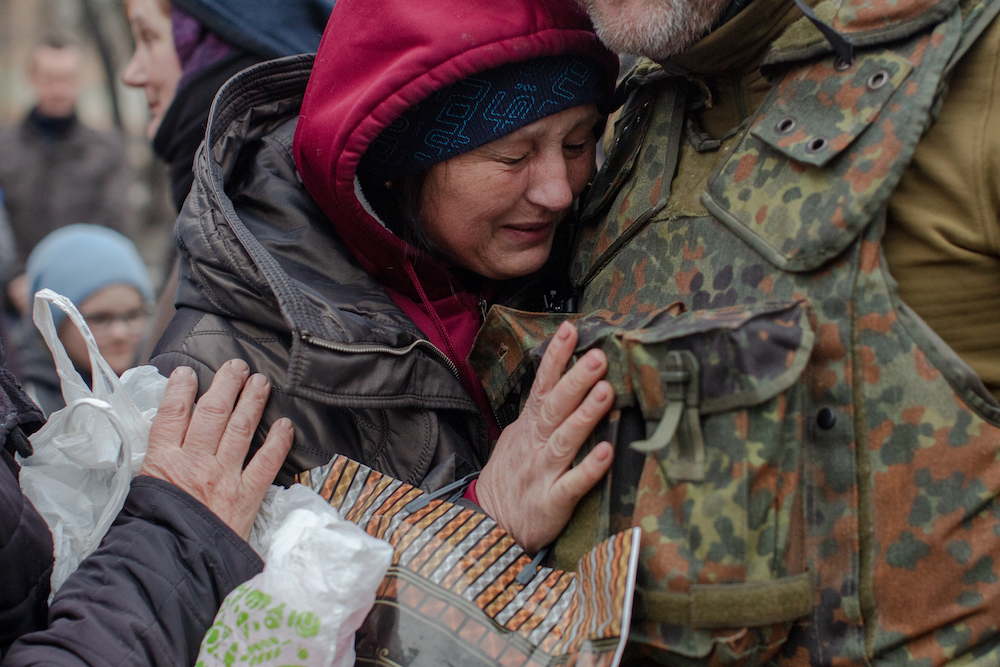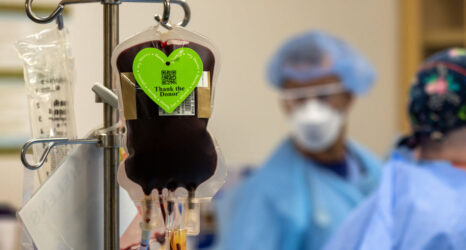
Award-winning, Brooklyn-based photojournalist Natalie Keyssar says that the six weeks she spent in Ukraine and at the Poland-Ukraine border gave her an opportunity to see the best of humanity.
But she also admits that she saw absolute horror—dead bodies in the streets, historic buildings and homes bombed into rubble, and people desperate to get themselves and their children out of harm’s way. Her photos depict grit and determination, as well as sorrow, and offer vivid testimony to the resistance on display in much of Ukraine.
“Despite how awful it was, it was a privilege to be there,” Keyssar told me, “and I was moved by the solidarity and kindness I witnessed from the Ukrainian people. Sometimes, in times of crisis, conflict or violence, there’s in-fighting. I know there are disagreements among Ukrainians, and a range of political opinions—but unlike other situations I’ve witnessed, the people are united and singularly focused on helping each other and defending their homeland.”
Keyssar’s photos—the majority documenting the upended lives of women, children and elders—poignantly capture this cohesion.
Alongside reporter Amie Ferris Rotman, Keyssar traveled to Przemyśl, Poland, as well as to Ukrainian cities including Borodyanka, Bucha, Hostemel, Irpin, Kyiv and Lviv. Her wartime photos, and Rotman’s reporting, have appeared in Time magazine, Germany’s Die Zeit, and Switzerland’s NZZ.
She spoke to Ms. in early May.
Eleanor Bader: Like Many Jewish Americans, your lineage ties back to Ukraine. Did this influence your decision to photograph the war?
Natalie Keyssar: Three of my four great grandparents come from Ukraine and left during periods that were difficult for Jews. I’d always planned to travel there and see the country, but when the war started, I felt a strong pull to cover what was happening.
I grew up hearing stories about my Ukrainian great grandparents and felt a deep connection to them. Part of this came from an interview my father did with his grandmother, Zipa Reisa Keyssar, which he shared with me when I was growing up. Zipa came from a little village in central Ukraine and left for Odessa because girls could not get a good education in her town. This was in the early 1900s. In the interview she told my dad about the trains that ran through her village. She saw them as magical.
Her words about this were powerful to me since trains are now the safest way for people to get out of Ukraine and are relied upon to transport people to safety in the European Union. I couldn’t shake the sense that history was repeating. Zipa experienced war first-hand and her life took her from Ukraine, to life as a refugee in France, the U.K. and eventually the U.S.
I know there are disagreements among Ukrainians, and a range of political opinions—but unlike other situations I’ve witnessed, the people are united and singularly focused on helping each other and defending their homeland.
Natalie Keyssar
Bader: Your first stop was the border between Poland and Ukraine. Why did your first photographs concentrate on the international students who had been enrolled in Ukrainian universities?
Keyssar: I arrived on Sunday, February 27, and started shooting the next day. I’d already read several social media posts about the racism that African, Middle Eastern and Asian students were facing as they tried to leave, so this became my first focus. Prior to the war, Ukraine was a place where students could get a great, affordable education, especially in the fields of science, medicine, and technology, so a lot of students from Africa, Afghanistan and India went there to study.
As soon as I got to the border crossing, I saw Black and Brown students sleeping on the ground and heard horror story after horror story about the discrimination they’d encountered as they scrambled to safety. The commonality of their experiences was painful.
Bader: After taking photos at the border, you and journalist Amie Ferris Rotman went into Ukraine. Why did you leave the border?
Keyssar: We started off at the Przemysl train station in Poland and saw two distinct narratives emerging. One followed the flood of women—young and old, with and without children—fleeing Ukraine; their stories were already getting a lot of coverage.
A second story was getting much less attention: A large number of women who had been abroad, working or traveling, were heading back into Ukraine. Some were returning to reunite with their children or parents. Others were returning to fight. This story led us to Lviv.
Bader: What did these women tell you?
Keyssar: Many of the women we met were heading to the eastern part of the country or to Kyiv. They told us that they had to get back to their children or parents.
One woman had been living in Israel but her kids were still in Ukraine. She was returning and planned to take them out of the country.
Another woman had been working in Poland and sending money home. Her family was in the east, in a region that had fallen to Russian control. She was terrified about what that would mean.
Another story involved a woman who left her son in Mariupol with his father. She had gone to Barcelona on vacation, her first holiday in three years. The war began while she was away. This vibrant young woman had lost contact with her eight-year-old son and was in a state of absolute panic. She was checking her phone a thousand times a day and every news item about Mariupol felt like a catastrophe to her.
Finally, the day before the Russian military bombed the theater, her ex-husband was able to get a cell phone signal and called to say that they were okay. It was a happy but harrowing ending.
Bader: Are women playing a role in the actual fighting?
Keyssar: The majority of soldiers on the frontlines are men but there are some women who are fighting. There are also lots of female medics and women who are taking massive personal risks to get food to people at the front.
Remember: No one is being drafted to fight. People of all genders are signing up, eager to join the armed forces.
Remember: No one is being drafted to fight. People of all genders are signing up, eager to join the armed forces.
Natalie Keyssar
Bader: How did you keep yourself together enough to listen to people’s stories and take photos?
Keyssar: The stories we heard were often excruciating. Being surrounded by people whose loved ones are in danger is hard and Amie and I spent a lot of time with people who are suffering. Over time, I’ve gotten better at feeling my emotions in real time—staying fully present with people as they share their pain. Nonetheless, I think it’s also important to stay strong and in control because it’s about their pain, not ours.
But it was a lot to take in. Grandmothers, as well as young women with children, were sharing so much with us. At the same time, there was a sense of sisterhood, of women supporting one another. It was really inspiring.
The journalism community was also a big source of personal support for me. Actually, I would have been broken without them. We gave one another room to vent and share experiences so that we could do the work properly.
Bader: Was there anything that surprised you about what you witnessed?
Keyssar: The Ukrainian people are amazing, really generous and gracious. For example, even though they’ve set up military checkpoints throughout the country, the soldiers I encountered were friendly and welcoming. It was incredible, unlike any other militarized zone I’d ever seen.
Another surprise—and I think this has stunned the world but not people familiar withUkraine—is the amount of Ukrainian resistance. The solidarity people show toward each other is extraordinary. Every single person I encountered was doing what they could to help the troops and assist displaced people. Everyone was united behind this purpose, whether it meant turning a restaurant into a soup kitchen, translating documents, or doing logistical work. Their passion for independence and sovereignty is contagious.
Another aspect that seemed rare to me, is that in some ways the story of this war is truly a simple conflict between good and evil, with an invading force fighting against people who are protecting and defending their homes. That’s it.
The Ukrainians have an indomitable spirit which I believe accounts for the fact that Russia has been unable to reach its goal. The vast majority of the country remains intact and the Ukrainian military has done a good job of holding the line. Of course, this has been at great cost and the government has asked again and again for more international support. There is now hope that the latest U.S. aid package will enable Ukraine to reverse Russia’s military advantage.
No one can predict what will happen in the future, but I feel that if the rest of the world does its part to support Ukraine, they will win.
Up next:





